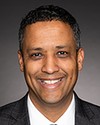Mr. Chair, thank you very much for the opportunity to speak to you and members. I will be speaking about facial recognition technology in terms of the individual, digital society and government.
I am a consultant in the areas of strategic foresight, scenario planning and global change, and I am an adjunct professor in the Master of Public Policy in Digital Society program at McMaster University.
A key foresight method that I use for planning for the future is scenario planning. As Canada navigates the most uncertainty it has faced since the start of the post-war period, scenario planning can play a role in helping legislators to inform resilient strategy and public policy. I see the following as important issues to address with facial recognition, which I will refer to as FRT.
One, people are being targeted by FRT without meaningful consent and/or in ways they do not understand. Two, societies that are increasingly unequal include populations of people who cannot advocate for their interests related to FRT's current or possible use. Three, legislators will always be behind the curve if they do not take the time to explore the plausible futures of digital society and the role of novel technologies such as FRT within them.
I will speak to these concerns from the perspectives of the individual, of society and of government.
In terms of the individual, our faces open doors for us and can lead to doors being closed on us. We experience biases across the spectrum from negative to positive and implicit to explicit based on how our faces are perceived and on other factors related to our appearance. This fundamental reality shapes our lives.
With an FRT-enabled world, what might it mean to be recognized by technical systems in which FRT is embedded?
What might it mean for FRT to be combined with sentiment analysis to quickly identify feelings at vulnerable moments when a person might be swayed or impacted by commercial, social or political manipulation?
What might it mean for a person to be identified as a potential social, political or public safety threat by FRT embedded into security robots?
What might it mean for a person to be targeted as a transactional opportunity or liability by FRT embedded into gambling or commercial services?
Technologies associated with FRTs, such as big data, machine learning and artificial intelligence, amplify these potential risks and opportunities of FRT and other biometric technologies. While some individuals may welcome FRT, many are concerned about being targeted and monitored. In cases in which rights are infringed, individuals may never know how or why; companies may choose not to reveal the answers, and there may not be meaningful consent.
In such cases, there will be no accessible remedies for individuals impacted by commercial, legal or human rights breaches.
In terms of digital society, Canadian society faces unprecedented challenges. Rising social and racial inequalities in our country have been worsened greatly by the pandemic. Canadians are experiencing chronic stress and declining physical and mental health. Social resilience is undermined by disinformation and misinformation. Canada is addressing new and threatening challenges to the post-war order. The climate crisis is a co-occurring threat multiplier.
Despite these challenges, major technology companies are profiting from opportunities amidst the unprecedented risk and so have gained additional leverage in relation to government and our digital society. In the process, a few companies have accrued considerable power with trillion-dollar-plus valuations, large economic influence and a lock on machine learning and artificial intelligence expertise.
As I speak, technology leaders are imagining the next FRT use cases, including how FRT might be used more widely in business, government and industry. Some tech companies are exploring threats and opportunities that would justify use cases that may be unlawful today but could be viable in new circumstances, from a change in government to a shocking security event to changes in labour laws.
In terms of government, a society facing constant disruption has not proved to be a universally safe one for Canadians. The realities of harms and potential harms to individuals and of the risks and opportunities for business and government puts effective governance in the spotlight. At a time of unprecedented risk, parliamentarians have a responsibility to make sense of societal change and to comprehend plausible futures for FRT amidst the use of sophisticated surveillance systems in “smarter” cities, growing wealth and income inequality, threatened rights of children and marginalized communities.
Creating effective law and policy related to FRT should involve due contemplation of plausible futures.
I respect that for you, as legislators, this is a challenging task, given the often short-term horizons of elected individuals and parties. However, prospective thinking can complement the development of legislation to deal with novel and often unanticipated consequences of technologies as potent as FRT, which is inextricably linked with advances in computer vision, big data, human computer interaction, machine learning, artificial intelligence and robotics.











